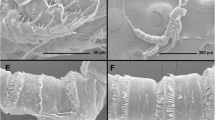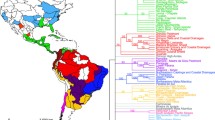Abstract
Dirivultid copepods are among the most successful organisms at deep-sea hydrothermal vents, as this family includes 50 morphologically described species. We studied COI diversity of some species in various geographical areas and vent fluid regimes, in order to gain a better understanding of true species diversity, dispersal strategies, and evolution. DNA taxonomy revealed the same entities as described with morphological characters. No cryptic species were detected. With the help of COI analyses, it was possible to identify a new species and match the dimorphic sexes of another species. The geographical distance between vents, as well as the extreme physico-chemical environment, are thought to affect the gene flow of fauna. We could not detect any sequence differences within species among different geographical scales (up to 2,000 km) or different vent fluid regimes. We suggest that Dirivultidae have relatively high gene flow between vents and are able to disperse relatively easy along ridges. Further, they have a broad physiological tolerance and thus might not have undergone speciation in response to heterogeneity caused by vent fluids.


Similar content being viewed by others
References
Barraclough TG, Birky CW, Burt A (2003) Diversification in sexual and asexual organisms. Evolution 57:2166–2172
Black MB, Lutz RA, Vrijenhoek RC (1994) Gene flow among vestimentiferan tube worm (Riftia pachyptila) populations from hydrothermal vents of the Eastern Pacific. Mar Biol 120:33–39
Bright M (2006) Hydrothermal vent meiofauna. In: Desbruyères D, Segonzac M, Bright M (eds) Handbook of hydrothermal vent fauna. Denisia, Linz, pp 27–28
Bucklin A, Wiebe PH (1998) Low mitochondrial diversity and small effective population sized of the copepods Calanus finmarchicus and Nannocalanus minor: possible impact of climatic variation during recent glaciations. Am Genet Assoc 89:383–392
Bucklin A, Guarnieria M, McGillicuddy DJ, Hill RS (2001) Spring evolution of Pseudocalanus spp. abundance on Georges Bank based on molecular discrimination of P. moultoni and P. newmani. Deep Sea Res Pt II 48:589–608
Bucklin A, Frost BW, Bradford-Grieve J, Allen LD, Copley NJ (2003) Molecular systematic and phylogenetic assessment of 34 calanoid copepod species of the Calanidae and Clausocalanidae. Mar Biol 142:333–343
Carney SL, Peoples JR, Fisher CR, Schaeffer SW (2002) AFLP analyses of genomic DNA reveal no differentiation between two phenotypes of the vestimentiferan tubeworm, Ridgea picesae. Cah Biol Mar 43:363–366
Carney SL, Flores JF, Orobona KM, Butterfield DA, Fisher CR, Schaeffer SW (2007) Environmental differences in hemoglobin gene expression in the hydrothermal vent tubeworm, Ridgeia piscesae. Comp Biochem Phys B 146:326–337
Caudill CC, Bucklin A (2004) Molecular phylogeography and evolutionary history of the estuarine copepod, Acartia tonsa, on the Northwest Atlantic coast. Hydrobiologia 511:91–102
Cohan FM (2001) Bacterial species and speciation. Syst Biol 50:513–524
Craddock C, Lutz RA, Vrijenhoek RC (1997) Patterns of dispersal and larval development of archaeogastropod limpets at hydrothermal vents in the eastern Pacific. J Exp Mar Biol Ecol 210:37–51
Di Meo-Savoie CA, Luther GW III, Cary SC (2004) Physico-chemical characterization of the microhabitat of the epibionts associated with Alvinella pompejana, a hydrothermal vent annelid. Geochim Cosmochim Ac 68:2055–2066
Eberl R, Cohen S, Cipriano F, Carpenter EJ (2007) Genetic diversity of the pelagic harpacticoid copepod Macrosetella gracilis on colonies of the cyanobacterium Trichodesmium spp. Aquat Biol 1:33–43
Edmans S (2001) Phylogeography of the intertidal copepod Tigriopus californicus reveals substantially reduced population differentiation at northern latitudes. Mol Ecol 10:1743–1750
Etter RJ, Mullineaux LS (2001) Deep-sea Communities. In: Bertness MD, Gaines SD, Hay ME (eds) Marine community ecology. Sinauer Associates, Sunderland, pp 367–394
Folmer O, Black M, Hoeh W, Lutz R, Vrijenhoek R (1994) DNA primers for amplification of mitochondrial cytochrome c oxidase subunit I from diverse metazoan invertebrates. Mol Mar Biol Biotech 3:294–299
Fontaneto D, Kaya M, Herniou EA, Barraclough TG (2009) Extreme levels of hidden diversity in microscopic animals (Rotifera) revealed by DNA taxonomy. Mol Phylogenet Evol 53:182–189
Galkin SV, Goroslavskaya EI (2008) Bottom fauna associated with mussel beds and alvinellid communities in the hydrothermal field at 9°N of the East Pacific Rise. Oceanology 48(4):509–516
Giere O (2009) Meiobenthology, the microscopic fauna in aquatic sediments. Springer, Berlin, p 527
Goetze E (2003) Cryptic speciation on the high seas; global phylogenetics of the copepod family Eucalanidae. Proc R Soc Lond B 270:2321–2331
Goffredi SK, Hurtado LA, Hallam S, Vrijenhoek RC (2003) Evolutionary relationships of deep-sea vent and seep clams (Mollusca: Vesicomyidae) of the ‘pacifica/lepta’ species complex. Mar Biol 142:311–320
Gollner S, Zekely J, Van Dover CL, Govenar B, Le Bris N, Nemeschkal H, Bright M (2006) Benthic copepod communities associated with tubeworm and mussel aggregations on the East Pacific Rise. Cah Biol Mar 47:397–402
Gollner S, Zekely J, Govenar B, Nemeschkal HL, Le Bris N, Fisher CR, Bright M (2007) Tubeworm-associated permanent meiobenthic communities from two chemically different hydrothermal vent sites on the East Pacific Rise. Mar Ecol Prog Ser 337:39–49
Gollner S, Riemer B, Martínez Arbizu P, Le Bris N, Bright M (2010a) Diversity of meiofauna from the 9°50′N East Pacific Rise across a gradient of hydrothermal fluid emissions. PLoS ONE 5(8):e12321. doi:10.1371/journal.pone.0012321
Gollner S, Ivanenko VI, Martínez Arbizu P, Bright M (2010b) Advances in taxonomy, ecology, and biogeography of Dirivultidae (Copepoda) associated with chemosynthetic environments in the deep sea. PLoS ONE 5(8):e9801. doi:10.1371/journal.pone.0009801
Govenar B, Le Bris N, Gollner S, Glanville J, Aperghis A, Hourdez S, Fisher CR (2005) Epifaunal community structure associated with Riftia pachyptila aggregations in chemically different hydrothermal vent habitats. Mar Ecol Prog Ser 305:67–77
Guindon S, Gascuel O (2003) A simple, fast, and accurate algorithm to estimate large phylogenies by maximum likelihood. Syst Biol 52:696–704
Herbert PDN, Cywinska A, Ball SL, de Waard JR (2003) Biological identifications through DNA barcodes. Proc Biol Sci 270:313–321
Hill RS, Allen LD, Bucklin A (2001) Multiplexed species-specific PCR protocol to discriminate four N. Atlantic Calanus species, with an mtCOI gene tree for ten Calanus species. Mar Biol 139:279–287
Hornik K (2009) R. ISBN 3-900051-08-9: http://CRAN.R-project.org/doc/FAQ/R-FAQ.html
Hurtado LA, Lutz RA, Vrijenhoek RC (2004) Distinct patterns of genetic differentiation among annelids of the Eastern Pacific hydrothermal vents. Mol Ecol 13:2603–2615
Huys R, Llewellyn-Hughes J, Conroy-Dalton S, Olson PD, Spinks JN, Johnston DA (2007) Extraordinary host switching in siphonostomatoid copepods and the demise of the Monstrilloida: integrating molecular data, ontogeny and antennulary morphology. Mol Phylogenet Evol 43(2):368–378
Ivanenko VN (1998) Deep-sea hydrothermal vent copepoda (Siphonostomatoida, Dirivultidae) in plankton over the Mid-Atlantic Ridge (29°N), morphology of their first copepodid stage. Zool Zh 77(1):1249–1256
Ivanenko VN, Martínez Arbizu P, Stecher J (2007) Lecithotrophic nauplius of the family Dirivultidae (Copepoda; Siphonostomatoida) hatched on board over the Mid-Atlantic Ridge (5°S). Mar Ecol 28:49–53
Johnson SB, Warén A, Vrijenhoek RC (2008) DNA barcoding of Lepetodrilus limpets reveals cryptic species. J Shellfish Res 27:43–51
Jollivet D, Desbruyères D, Moraga D, Bonhomme F (1995) Genetic differentiation of deep-sea hydrothermal vent alvinellid populations (Annelida: Polychaeta) along the East Pacific Rise. Heredity 74:376–391
Jousselin E, Desdevises Y, d’Acier AC (2009) Fine-scale cospeciation between Brachycaudus and Buchnera aphidicola: bacterial genome helps define species and evolutionary relationships in aphids. Proc Roy Soc Lond B-Biol Sci 276:187–196
Keane TM, Creevey CJ, Pentony MP, Naughton TJ, McInerney JO (2006) Assessment of methods for amino acid matrix selection and their use on empirical data shows that ad hoc assumptions for choice of matrix are not justified. BMC Evol Biol 6:29
Kingston Tivey M (2007) Generation of seafloor hydrothermal vent fluids and associated mineral deposits. Oceanography 20(1):50–65
Le Bris N, Zbinden M, Gaill F (2005) Processes controlling the physico-chemical micro-environments associated with Pompeii worms. Deep Sea Res Pt I 52:1071–1083
Machida R, Tsuda A (2010) Dissimilarity of species and forms of planktonic Neocalanus copepods using mitochondrial COI, 12S, nuclear ITS, and 28S gene sequences. Plos One 5(4):1–6
Matabos M, Thiébaut E, Le Guen D, Sadisky F, Jollivet D, Bonhomme F (2008) Geographic clines and stepping-stone patterns detected along the East Pacific Rise in the vetigastropod Lepetodrilus elevatus reflect species crypticism. Mar Biol 153:545–563
Oksanen J, Kindt R, Legendre P, O’Hara B, Simpson GL, Solymos P, Stevens MHH, Wagner H (2009) vegan: Community Ecology Package. R package version 1.15–4. http://CRAN.Rproject.org/package=vegan
Palmer MA (1988) Meiofauna dispersal near natural petroleum seeps in the Santa Barbara Channel: a recolonization experiment. Oil Chem Pollut 4:179–189
Podowski EL, Moore TS, Zelino KA, Luther GW III, Fisher CR (2009) Distribution of diffuse flow megafauna in two sites on the Eastern Lau Spreading Center, Tonga. Deep Sea Res Pt I 56:2041–2056
Pons J, Barraclough TG, Gomez-Zurita J, Cardoso A, Duran DP, Hazell S, Kamoun S, Sumlin WD, Vogler AP (2006) Sequence based species delimitation for the DNA taxonomy of undescribed insects. Syst Biol 55:595–609
Ronquist F, Huelsenbeck JP (2003) MrBayes 3: Bayesian phylogenetic inference under mixed models. Bioinformatics 19:1572–1574
Rozas J, Sanchez-Del Barrio JC, Messeguer X, Rozas R (2003) DNASP, DNA polymorphism analyses by the coalescent and other methods. Bioinformatics 19:2496–2497
Slatkin M (1993) Isolation by distance in equilibrium and non-equilibrium populations. Evolution 47:264–279
Southward EC, Tunnicliffe V, Black M (1995) Revision of the species Ridgeia from the northeast Pacific hydrothermal vents, with a redescription of Ridgeia piscesae Jones (Pogonophora: Obturata = Vestimentifera). Can J Zool 73:282–295
Tsurumi M, de Graaf RC, Tunnicliffe V (2003) Distributional and biological aspects of copepods at hydrothermal vents on the Juan de Fuca Ridge, north-east Pacific Ocean. J Mar Biol Ass UK 83:469–477
Tunnicliffe V (1992) The nature and origin of the modern hydrothermal vent fauna. Palaios 7:338–350
Van Dover CL (2000) The ecology of hydrothermal vents. Princeton University Press, Princeton New Jersey
Van Dover CL, German CR, Speer KG, Parson LM, Vrijenhoek RC (2002) Evolution and biogeography of deep-sea vent and seep invertebrates. Science 295:1253–1257
Vrijenhoek RC (1997) Gene flow and genetic diversity in naturally fragmented metapopulations of deep-sea hydrothermal vent animals. Heredity 88:285–293
Vrijenhoek RC (2009) Cryptic species, phenotypic plasticity, and complex life histories: assessing deep-sea faunal diversity with molecular markers. Deep Sea Res Pt II 56:1713–1723
Vrijenhoek RC, Schutz SJ, Gustafson RG, Lutz RA (1994) Cryptic species of deep-sea clams (Mollusca, Bivalvia, Vesicomyidae) in hydrothermal vent and cold-seep environments. Deep Sea Res Pt II 41:1171–1189
Watanabe H, Tsuchida S, Fujikura K, Yamamoto H, Inagaki F, Kyo M, Kojima S (2005) Population history associated with hydrothermal vent activity inferred from genetic structure of neoverrucid barnacles around Japan. Mar Ecol Prog Ser 288:233–240
Wright S (1951) The genetical structure of populations. Ann Eugen 15:323–354
Acknowledgments
We warmly thank Charles Fisher (PennState University, USA), Monika Bright (University of Vienna, Austria), and Stefan Sievert (WHOI, USA) for inviting us on their cruises allowing us to collect excellent copepod material. Special thanks go to the captains, crew, pilots, and scientists (especially Ingrid Kolar, Laura Riavitz (both University of Vienna), and Dominique Cowart (PennState University, USA)) for their amazing help during the sea-going expeditions. Timothy G. Barraclough provided the GMYC code programmed in R2.9.2. This work was supported by the ChEss Mini-Grant (to SG), the Alexander von Humboldt Foundation (to SG), the Austrian Science Foundation grant FWF (P20190-B17 to M. Bright), and the US National Science Foundation grant (OCE 0732333 to C. Fisher). We are indebted to the Alfred Sloan Foundation for their generous support to the Census of Marine Life, to which this manuscript contributes.
Author information
Authors and Affiliations
Corresponding author
Additional information
Communicated by S. Uthicke.
Electronic supplementary material
Below is the link to the electronic supplementary material.
Rights and permissions
About this article
Cite this article
Gollner, S., Fontaneto, D. & Martínez Arbizu, P. Molecular taxonomy confirms morphological classification of deep-sea hydrothermal vent copepods (Dirivultidae) and suggests broad physiological tolerance of species and frequent dispersal along ridges. Mar Biol 158, 221–231 (2011). https://doi.org/10.1007/s00227-010-1553-y
Received:
Accepted:
Published:
Issue Date:
DOI: https://doi.org/10.1007/s00227-010-1553-y




